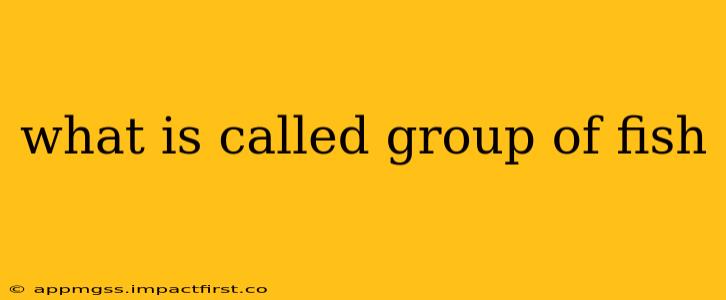The collective noun for a group of fish depends heavily on the type of fish and even the context. There isn't one single answer! While "school" is the most commonly used and widely recognized term, it's not universally applicable. Let's dive deeper into the fascinating world of fish groupings.
What is a school of fish?
A school of fish is a large group of fish of the same species swimming together in a coordinated manner. This coordinated movement is a crucial survival mechanism, offering protection from predators through strength in numbers and improved foraging efficiency. Think of sardines, herring, or anchovies – these are classic examples of fish that school. The synchronized swimming isn't random; it's a complex behavior involving visual cues, lateral line sensing (detecting vibrations in the water), and even chemical signals.
Are all groups of fish called schools?
No, definitely not! While "school" is widely understood, it's incorrect for many types of fish groupings. The term is best reserved for those exhibiting coordinated, synchronized swimming. Other collective nouns exist, adding nuance and specificity to fish aggregations.
What are other collective nouns for groups of fish?
Here are some alternative terms, highlighting the diversity of fish behavior and grouping patterns:
- Shoal: This term often overlaps with "school," but it generally refers to a less organized aggregation of fish, perhaps of mixed species, feeding or moving together without the tight synchronization of a school.
- Gait: This term is used less frequently but applies to groups of fish, especially those moving in a more erratic, less organized way than a school or shoal.
- Run: Often used for migrating salmon or other fish moving in large groups for spawning.
- Pod: This collective noun is sometimes used for smaller groups of certain species, such as dolphins, but can also apply to some types of fish, particularly those exhibiting social behavior.
- Drift: This term describes a group of fish passively drifting together, often affected by currents.
- A host of fish: A more poetic or literary term, referring to a very large number of fish.
The best term to use always depends on the specific species and the behavior of the group.
What are some specific examples of fish group names?
Certain species have specific collective nouns associated with them. While these aren't universally used, they illustrate the richness of language related to aquatic life. Examples might include a "battery" of ray fish or a "bloom" for smaller species such as jellyfish (although jellyfish aren't technically fish).
Why are there different terms for groups of fish?
The variety of terms reflects the incredibly diverse social behaviors and ecological strategies found within the fish kingdom. Some fish are solitary, others form loose aggregations, while still others exhibit the highly coordinated schooling behavior. The language we use aims to capture this biological diversity.
How do fish communicate to form groups?
Fish employ a variety of methods for communication, influencing schooling and shoaling behaviors:
- Visual cues: Fish can see each other and react to the movements of their neighbors.
- Lateral line system: This sensory organ detects vibrations and water currents, allowing fish to sense the position and movement of nearby fish.
- Chemical signals: Some fish release pheromones that can attract other fish of the same species.
- Sound: Some fish produce sounds that may play a role in communication and group formation.
By understanding the nuances of fish behavior and communication, we can appreciate the varied and fascinating terms used to describe their complex social structures. The next time you observe a group of fish, remember that simply calling it a "school" might be an oversimplification!
